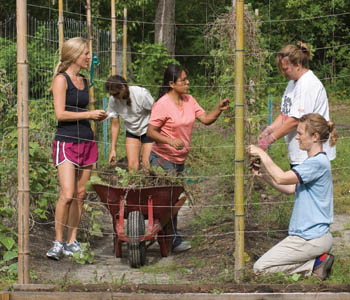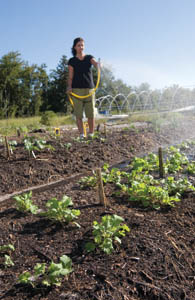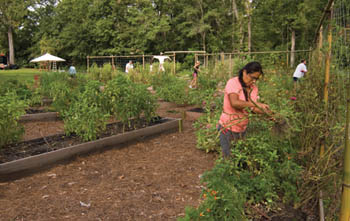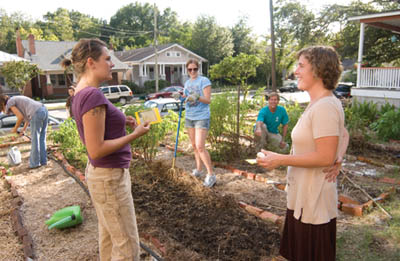Community Gardens: If you grow it they will come
BY Jamie Walker
At a time when our nation’s First Lady can be found weeding and harvesting in the first White House garden since Eleanor Roosevelt’s 1940 “victory garden ” the pressure to grow one’s own food is on. In April faced with preparing and maintaining an ambitious organic garden Mrs. Obama sought assistance and found it in a community of gardeners — a lively group of fifth graders. Local farmer Christin Deener is the manager of the Beach Road Farm Community Garden and the co-operator of Federal Point Farm Deener’s gardening career blossomed when she worked as an Americorp Vista volunteer for the community gardening organization South Eastern Efforts Developing Sustainable Spaces (SEEDS) in Durham North Carolina. “A community garden is like a club ” she says. “You have to establish its purpose early on. The members have to decide ‘Okay is this about beautification community building feeding our families?’ Once that’s established the way is clearer.” Once the way is clear Deener points out that finding the perfect space for a community garden takes creativity and determination. Workplaces churches schools nonprofit organizations and residential lot owners are often willing to donate green space to the worthy causes of community building and sustainability. “When you know why and you know where ” Deener says “studying and getting involved in local existing community gardens is the best way to start.” Beach Road Community Gardens Deener’s two acres of lush gardens painted with vibrant blotches of summer vegetable color to the right and floral gems to the left provide a red-carpeted entrance to the 1/4-acre community garden section at Beach Road Farms. Each of the six community gardeners has their own plot measuring 20 feet by 40 feet. Beach Road Community Gardens is a gardener’s garden. The members include master gardeners home-schooling families and a group of chefs from Circa 1922 the landmark Historic Downtown Wilmington restaurant. The Beach Road garden plots are as diverse as the individual gardeners. Towering sunflowers slated for a 4H bird seed project encompass the northwestern-most plot and call to farm visitors like a billboard. The comparatively fine print of the adjacent vegetable plot is scribbled with a variety of tomatoes beans and squash growing wild and floppy. Another plot maintained by a local master gardener is a congested wonderland filled with varying plant sizes shapes and strategic garden structure. In one section the gardener intermingled corn squash and pole beans to create what is known as “Three Sisters Planting.” The corn stalks provide a trellis for the pole beans and the squash serves as a ground cover to deter encroaching weeds. “I have a lot to learn ” says first-time gardener Sara Kennedy as she studies the master gardener’s plot. Her plot is a neat display of perfectly aligned weed-free rows of summer plantings. “I feel like I’m winging it most of the time.” Kennedy’s affinity for cooking — and her desire to nourish her year-old daughter in the healthiest way possible — inspired her to read Alice Waters’ book The Art of Simple Food. Waters known as the “mother of slow food ” is the owner of the world famous Chez Panisse in Berkeley California. Her book inspired Kennedy to search for the perfect gardening opportunity that her small subdivision yard could not provide. “Alice Waters is my culinary hero.” Kennedy says. “I decided to try to follow in her footsteps. I want my daughter to be involved in this. I want her to see that this is where food comes from not from a freezing-cold grocery store.” Wrightsville Beach Communal Garden Wilmington’s first “communal” garden was implemented early this year by Kim and Don Lefler on a lot adjacent to Wrightsville Avenue less than a mile from Wrightsville Beach. The garden is hidden behind a brick road-front home and lies in the sun-soaked center of two acres of green space. The Leflers live on Harbor Island and have minimal space to grow anything. The two-acre plot had little garden potential when they bought it last year. After extensive clearing of overgrowth and dead trees the Leflers saw a window of opportunity. Since its inception the garden has almost doubled in size and there are now 12 families that visit weekly to care for the garden. Two families are assigned to each day of the week. In the height of summer gardeners work one to two hours at a time. The team members are expected to check off all completed tasks on prepared log-in sheets that are kept in the inspections box behind the compost bins. Membership has its costs right? Wrong. “There are no fees ” Kim Lefler says. Nobody rents a space or incurs any cost. We work together as a team. We work hard as a team.” The timbers that brace the raised beds and the bamboo stakes draped with tomato plants were provided by Old Ground Riverwood. Progressive Gardens provided the organic topsoil organic compost organic peat moss and pearlite that make up the garden’s recipe for success. The soil quickly proved worthy in the spring of this year. After planting more than 1 000 seeds in February the gardening families were rewarded with a plentiful harvest. Radishes onions lettuces broccoli cauliflower and various herbs overflowed into their kitchens. “This winter was so prolific. Each family probably fed 10-15 families in addition to their own ” Kim Lefler says. Maria Thompson one of the first communal garden members says that the support the garden offers is priceless. “There’s no way I could do everything I wanted to do in my own garden. There’s just so much space here and so much help.” Castle Street Community Garden Four blocks from the Cape Fear River in Historic Downtown Wilmington Kathryn Sisler is harvesting her own flowers in the Castle Street Community Garden. Sisler an herbalist is also the manager and founder of Castle Street Community Garden. After completing an apprenticeship at Earthhaven — an aspiring ecovillage in a mountain forest setting near Asheville North Carolina dedicated to caring for people and the Earth by learning living and demonstrating a holistic sustainable culture — Sisler needed a place that she could grow and harvest herbs. Although there were a few community gardens in and around downtown when she began her search she needed a space that she could more or less design herself. “I’ve never once felt overwhelmed or regretted the decision to take this on ” Sisler says. “It’s been nothing but enjoyment.” Sisler and her fellow gardeners climb the four concrete stairs that lead to the half herb/half vegetable garden every Sunday for an hour or two to communally harvest weed fertilize and water their garden. Nearly everything in the garden has been donated by local organizations businesses and individuals including the four rain barrels donated by the New Hanover County Arboretum. Some plants were grown from cuttings or seeds harvested from other gardens. Local horticulturist Claire Hetzel and master gardener Thomas Tewey were integral in helping design and prepare the garden. There is a small raised children’s garden situated behind rows of summer vegetables. A compost pile is located behind the garden. Navigating through this miniature farm by way of narrow paths lined with cardboard and mulch you get the sense that you aren’t in Historic Downtown Wilmington anymore. A passerby calls out over the perennial herb bed “Garden sure is pretty.” “Come on up and join us anytime ” Sisler calls back. There are no written rules at Castle Street Community Garden. If you donate $15 per year and want to garden you’re in. Locals are always welcome to pitch in and a number of them have. The garden log is a notebook kept near the garden gate. Although gardening is not always easy Sisler says that when people do it together it’s always fun. “I believe that people will become happier because this place exists.” she says. Local gardeners everywhere are joining the First Lady in an effort to literally dig themselves out of the fog of the current economic downturn. Community gardens have sprouted throughout the Cape Fear region allowing gardeners of all ages and experience to build partnerships based on the universal desire to grow food. These communal green spaces can be found tucked away in residential areas scattered around the downtown area and on established farm land.
Local gardeners everywhere are joining the First Lady in an effort to literally dig themselves out of the fog of the current economic downturn. Community gardens have sprouted throughout the Cape Fear region allowing gardeners of all ages and experience to build partnerships based on the universal desire to grow food. These communal green spaces can be found tucked away in residential areas scattered around the downtown area and on established farm land.s both located on an eight-acre former blueberry farm a few miles north of Snow’s Cut Bridge. Membership dues at Beach Road Community Gardens are $20 per month. The soil is tilled tested and amended with locally collected composted horse manure and other necessary nutrients. Gardeners have open access to water which is distributed through recovered fire hoses. There is a list of 22 farm rules and guidelines including basic information such as: no pets; no pesticides herbicides or synthetic fertilizer; and keep weeds to a minimum please!
Membership dues at Beach Road Community Gardens are $20 per month. The soil is tilled tested and amended with locally collected composted horse manure and other necessary nutrients. Gardeners have open access to water which is distributed through recovered fire hoses. There is a list of 22 farm rules and guidelines including basic information such as: no pets; no pesticides herbicides or synthetic fertilizer; and keep weeds to a minimum please!  “We said ‘Okay let’s just have a small garden. We’ll bring in a couple of friends; we’ll grow our own food in raised beds.’ That was the idea initially ” Kim Lefler says.
“We said ‘Okay let’s just have a small garden. We’ll bring in a couple of friends; we’ll grow our own food in raised beds.’ That was the idea initially ” Kim Lefler says. Her fortuitous connection to South Eastern Alliance for Community Change (SEACC) led her to community activists Rick and Naomi Mobbs who happened to own an empty downtown lot that needed a purpose. Sisler had little gardening experience but jumped on the opportunity to supply that purpose. Now less than eight months later Castle Street Community Garden members harvest more than their families can consume.
Her fortuitous connection to South Eastern Alliance for Community Change (SEACC) led her to community activists Rick and Naomi Mobbs who happened to own an empty downtown lot that needed a purpose. Sisler had little gardening experience but jumped on the opportunity to supply that purpose. Now less than eight months later Castle Street Community Garden members harvest more than their families can consume.
Find out more about community gardening!
American Community Garden Association
www.communitygarden.org
New Hanover County Arboretum
www.gardeningnhc.org (910) 798-7660 6206 Oleander Drive
Progressive Gardens
www.progressivegardens.com
(910) 395-1156 6005 Oleander Drive
Beach Road Farm Community Gardens
222 Heathcliff Road
Contact: Christin Deener (910) 352-4769
Castle Street Community Garden
317 Castle Street
Contact: Kathryn Sisler Kathryn.sisler@gmail.com
Wrightsville Avenue Communal Garden
(910) 256-6341
6261 Wrightsville Ave.